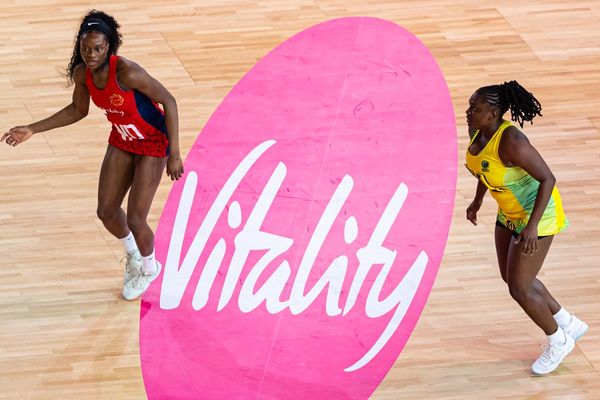
Jill Scott didn’t sleep a wink. She sauntered off the Wembley pitch, went straight into what was – by all accounts – a long and messy night of celebrations, and then simply bowled out of the team hotel on Monday morning to join the victory parade in London. Perhaps, for a stalwart midfielder who had just tasted victory in her 10th and very possibly last international tournament, she was fearful that if she slept she might eventually have to wake up.
And for a glowing but hungover nation, there remains a certain surreal dreamlike quality to the events at Wembley Stadium on Sunday evening. The very fact of victory was startling enough: a first major international trophy for 56 years in either the men’s or the women’s game, clinched on the sweet green grass of home. The manner of victory was more startling still: a winning goal in the 110th minute against the eight-time champions Germany, a lead skilfully and cynically sequestered in the final minutes with a display of time-wasting and gamesmanship that proved beyond doubt that the English can shithouse with the very best.
For fans reared on generations of English heartache, the sight of a bold and confident national side striding to six consecutive wins (not even the men’s sides of 1966 or 2021 could boast that) was its own devastating statement.
From Manchester to Brighton, Southampton to Sheffield, England played like the best team in the tournament because they believed they were from the very start. Unlike their predecessors under Phil Neville and Mark Sampson, they took the field with a clear plan and a united purpose.
More satisfying still was the way they dealt with the rich variety of tests put in front of them: the technical possession football of Spain, the organised counter-press of Sweden, the physicality and speed of Germany.
For the past two decades these have been the defining styles of European football, standards against which the English game has always been unfavourably measured. You might describe it as an inferiority complex being shed, were it not for the fact that there was no evidence such a complex existed in the first place.
But it is the wider context that feels the least credible of all: the way this team and this tournament have gripped the nation in a manner that only Olympic Games and men’s football have managed in recent years. World Cup triumphs in rugby union and cricket have fleetingly captured the attention.
But the rise of the Lionesses is irrefutable proof of the primacy of our national sport, a reminder that football can still touch the parts that no other sport can reach.
It wasn’t always this way, of course. Scott knows that better than anyone.
The journey that brought her to a sold-out Wembley on Sunday afternoon began with a substitute appearance against the Netherlands on a Thursday evening in 2006. This was the decadent heyday of the Sven-Göran Eriksson years, when the most famous women in English football were wives and girlfriends. By contrast, just under 8,000 people turned up at the Valley, which was open on only two of its four sides. The game was not televised.
It would be another eight years until Scott got to play at Wembley.

This is why it is impossible to conceive a ceiling for this England team, or indeed English women’s football in general. All over the world audiences, administrators and sponsors are waking up to the potential of women’s sport: 86,174 fans at the Cricket World Cup final in Melbourne in 2020, 91,553 at the Camp Nou in April, the rapid growth of the WNBA in the US. The current Sky/BBC television deal with the Women’s Super League is worth around £10m a season, which is roughly similar to what ITV was paying to show top‑flight men’s football until 1992. You may remember what happened next.
Those who play and watch women’s football have long since tired of unwise or fatuous comparisons with the men’s game. And yet its shadow remains inescapable, not simply as the frame of reference with which most of us grew up watching football but also as one of the primary sources of funding and potential new audiences for the women’s game. Similarly, the phenomenal boom in men’s football from the 1990s onwards offers both a road map and a warning. With growth comes attention, with attention comes revenue, and with revenue comes billionaire-ball, greed and immorality, inequality and exploitation, vultures and super-agents.
These are questions that the game is already beginning forced to grapple with, as the gulf between the biggest clubs and those further down the pyramid appears to widen and online tribalism increases with every passing season. Meanwhile the same tainted money that underpins the men’s game – Arsenal’s deal with Rwanda, Manchester City’s with Abu Dhabi, to take just two examples – also helps to pay the wages of Beth Mead and Leah Williamson and Keira Walsh and Chloe Kelly.
Can women’s football aspire to something similar but also something completely different? How far should a sport want to grow, and for what reasons? One of the main reasons the Lionesses have inspired such simple devotion this summer is that it has somehow managed to carve out its own vision of what football can be, not unconnected to the men’s game but still somehow separate and autonomous. The crowds have been young and largely gender-balanced. Fan culture has been imagined along the lines of inclusion and kindness, a safe space for young and old, people of colour, queer and non-binary people. Many of the England team are openly in same-sex relationships and nobody really cares.
This can be – must be – the way forward. When Williamson spoke so openly of the “change in society” that could be catalysed by this triumph, she was talking about more than symbolism and WSL attendances. She was talking about the power of sport to articulate a vision of the world as we hope it one day might be: fairer, more inclusive, more tolerant, more honest, more engaged with each other as people. Perhaps this strikes you as something of a fanciful task. But nobody ever became champions of Europe by dreaming small.







